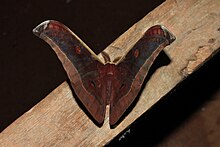Antheraea assamensis
| Antheraea assamensis | |
|---|---|
 |
|
| Antheraea assamensis male, Borneo | |
 |
|
| Caterpillars | |
| Scientific classification | |
| Kingdom: | Animalia |
| Phylum: | Arthropoda |
| Class: | Insecta |
| Order: | Lepidoptera |
| Family: | Saturniidae |
| Tribe: | Saturniini |
| Genus: | Antheraea |
| Species: | A. assamensis |
| Binomial name | |
|
Antheraea assamensis Helfer, 1837 |
|
| Synonyms | |
|
|
The muga silkworm is the larva of the Assam silkmoth (Antheraea assamensis), a moth of the Saturniidae family. It is found in northeast India (namely Assam) where 99% of its production occurs.
The larva feed on Cinnamomum, Laurus, Litsea, Carpinus, Persea, Magnolia, Michelia, Quercus, Sarcostemma and Symplocos.
Its silk, one of the varieties of Tussar silk, has a glossy golden hue which improves with age and washing. It is never bleached or dyed and is stain resistant. It was reserved for the exclusive use of royal families in Assam for 600 years. Like other silkmoths, the female have a larger abdomen and slender antennae when compared to males. The larvae are vibrantly coloured and are monophagous as other silkmoths.
In 2015, Adarsh Gupta K of Nagaraju's research team at Centre for DNA Fingerprinting and Diagnostics, Hyderabad, India discovered the complete sequence and the protein structure of Muga Silk Fibroin and published it in Nature (journal) Scientific Reports.
...
Wikipedia
